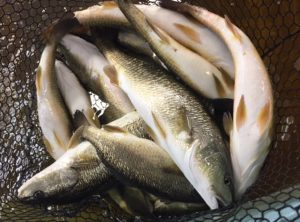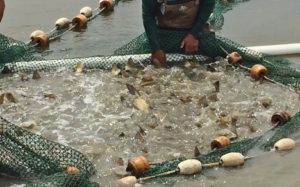Changes in Aquaculture Have Consumers Landing ‘Higher Value’ Fish
Consumer trends continue to drive an industry change from traditional aquaculture species like catfish to higher value species including redfish and hybrid striped bass, according to a Texas A&M AgriLife Extension Service expert.
Redfish are trending upward in price and consumer demand along with other alternative species like hybrid striped bass compared to traditional aquaculture species like catfish. (Texas A&M AgriLife Extension Service photo by Dr. Todd Sink)
Dr. Todd Sink, AgriLife Extension aquaculture and fisheries specialist, College Station, said catfish, a longtime staple for Texas fish production, has experienced a recent decline in pricing and popularity, causing producers to look at other options.
Catfish prices were around 93 cents per pound compared to the high of $1.35 per pound two years ago. As a result, discerning U.S. consumers are buying less catfish as household wealth and expendable income increase and because other options in the market are perceived as higher quality. Those include salmon, redfish and hybrid striped bass, which are a cross between white and striped bass, he said.
Sink said poor prices and consumer trends have some catfish producers switching at least a portion of production to other species like redfish and hybrid striped bass, which bring higher prices – $3-$3.30 per pound and $3.30-$3.60 per pound respectively – and are experiencing increased demand.
“It’s fairly clear that consumer tastes are changing from what is perceived as lower-quality fish to higher-end, higher-value fish,” he said. “The cyclical movement on catfish has been downward for a while, so you have a lot of producers looking to diversify with other options that are trending upward in both price and consumer demand.”
Redfish and hybrid striped bass can handle a range of salinity levels. Bass prefer fresh water to 10 parts per thousand salinity, while redfish are typically produced at five parts per thousand to full-strength seawater.
Redfish growth rate stalls when waters are 50 degrees or below, and freezing waters can cause die-offs without proper management, which limits production to warmer climates, Sink said. Hybrid striped bass are more tolerant of cool waters and are grown throughout the U.S., although their growth rate can also decrease drastically below 50 degrees.
Catfish production densities in Texas are around 12,000 pounds of fish per acre compared to 6,500 pounds of hybrid striped bass per acre and up to 8,000 pounds of redfish per acre, Sink said.
Texas is the No. 1 producer of redfish and hybrid striped bass, including around 98 percent of the nation’s redfish production and more than half of hybrid striped bass, Sink said. Established producers continue to expand their capacity to meet demand.
It’s difficult to ascertain redfish and hybrid striped bass production levels because U.S. Department of Agriculture census reports are infrequent, but Sink estimates Texas produces up to 2.7 million pounds of bass and 2.3 million pounds of redfish annually based on their 2013 report and farm expansions since that time.
Hybrid striped bass being harvested at a commercial aquaculture operation in Texas. (Texas A&M AgriLife Extension Service photo by Dr. Todd Sink)
By comparison, Texas ranks No. 4 in U.S. catfish production with 18.9 million pounds per year.
Several farms are expanding redfish production across Texas with one currently adding 200 acres of production capacity to its operation, which represents a 30 percent increase in overall production, Sink said. Hybrid striped bass production has been expanding at a 3-5 percent rate annually in Texas and southeastern states.
“We don’t expect to see any slowdown in the expansion of both the market and production to meet that market demand over the next five to 10 years,” Sink said. “They’re expanding as they can to supply consumers in a market that is just starting to take off.”
Sink said 90 percent of Texas’ hybrid striped bass production serves demand from high-end restaurants on East and West coasts, while nearly all of the state’s redfish production serves restaurants in large cities such as New Orleans and Houston.
“Producers are getting a premium price for their product, many farms are looking to expand, and some restaurants are operating their own farms just to ensure they can supply their consumer demand,” he said. “Right now they are serving niche markets, so there is room and reason to expand.”
Source: Texas AgriLife Extension


